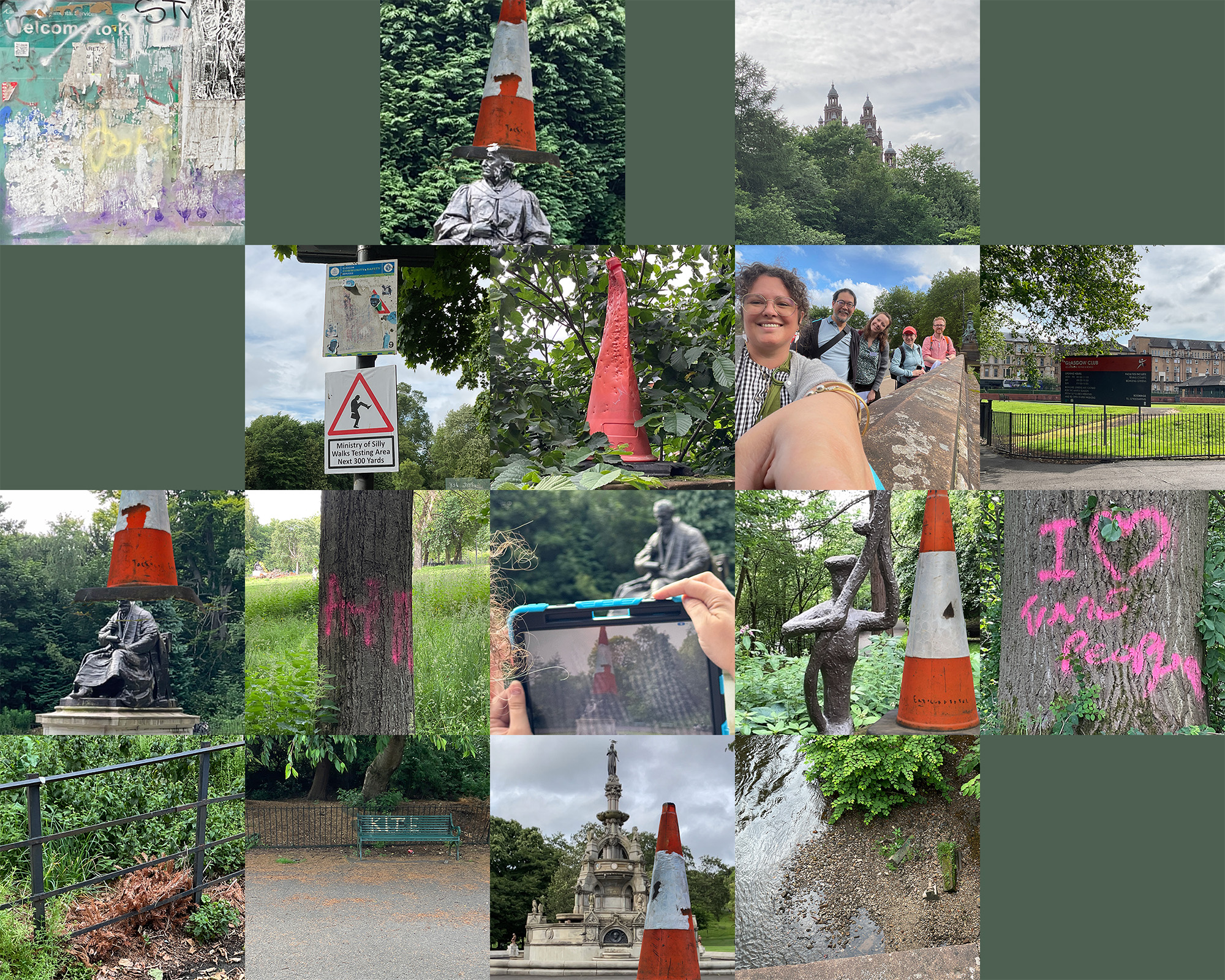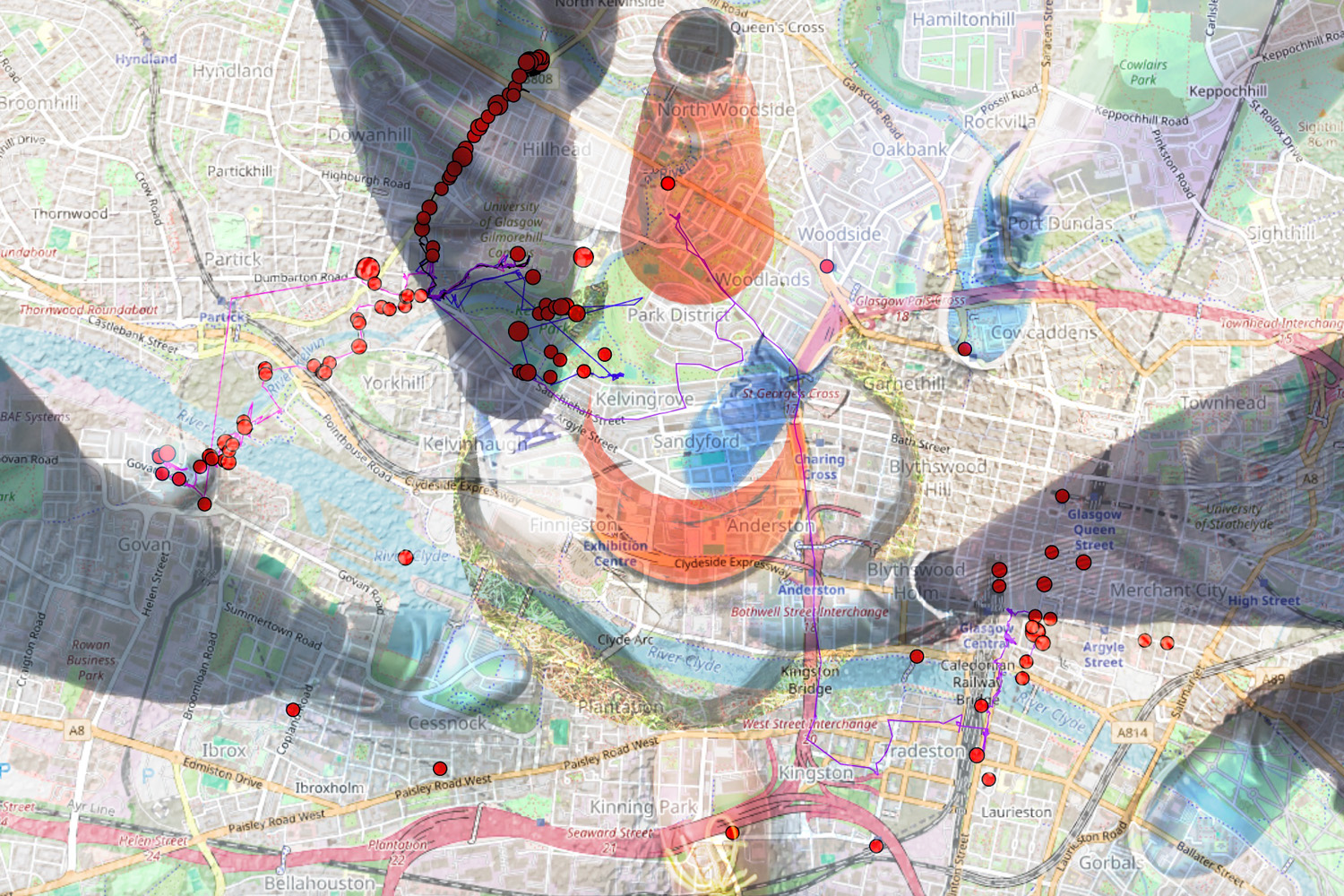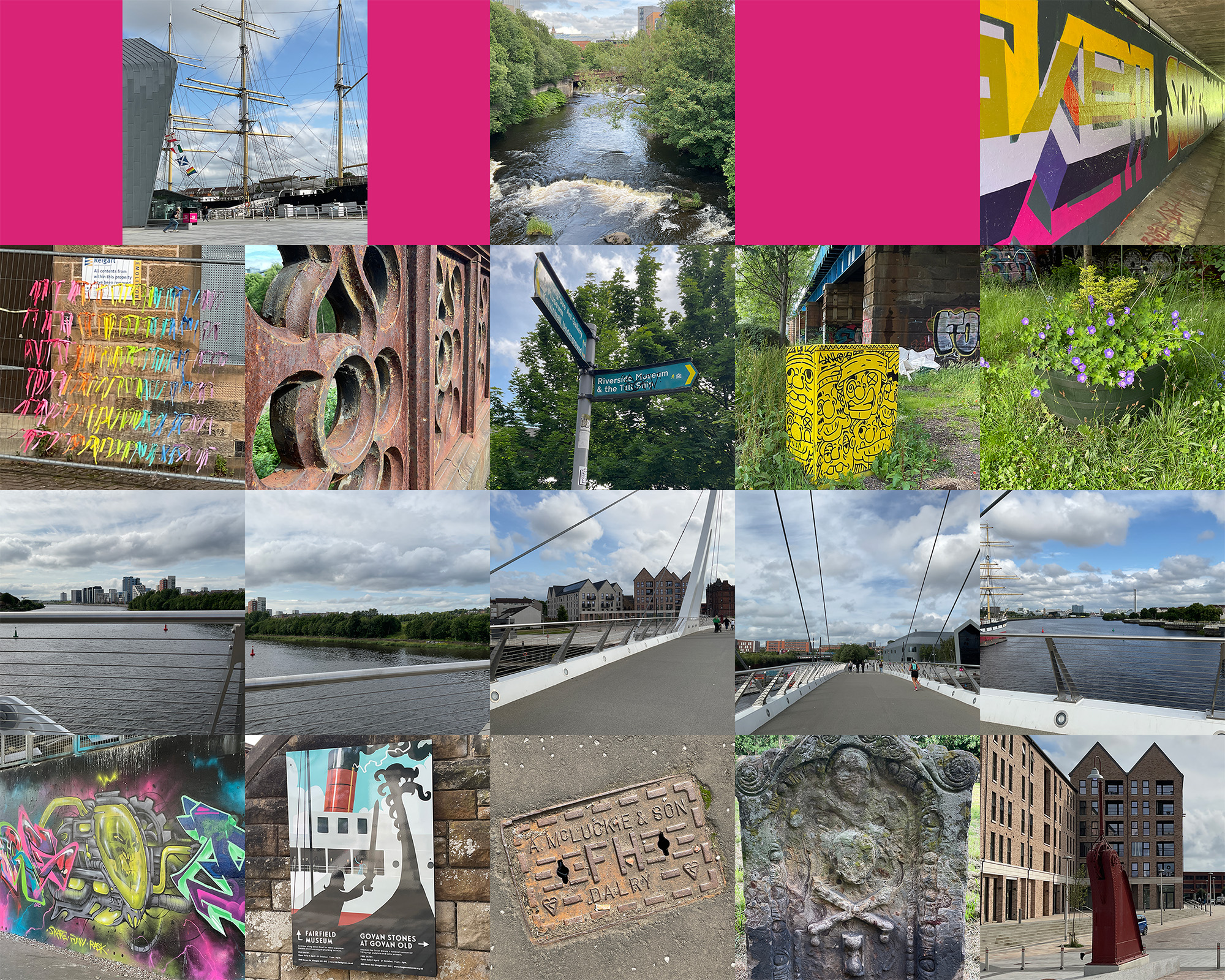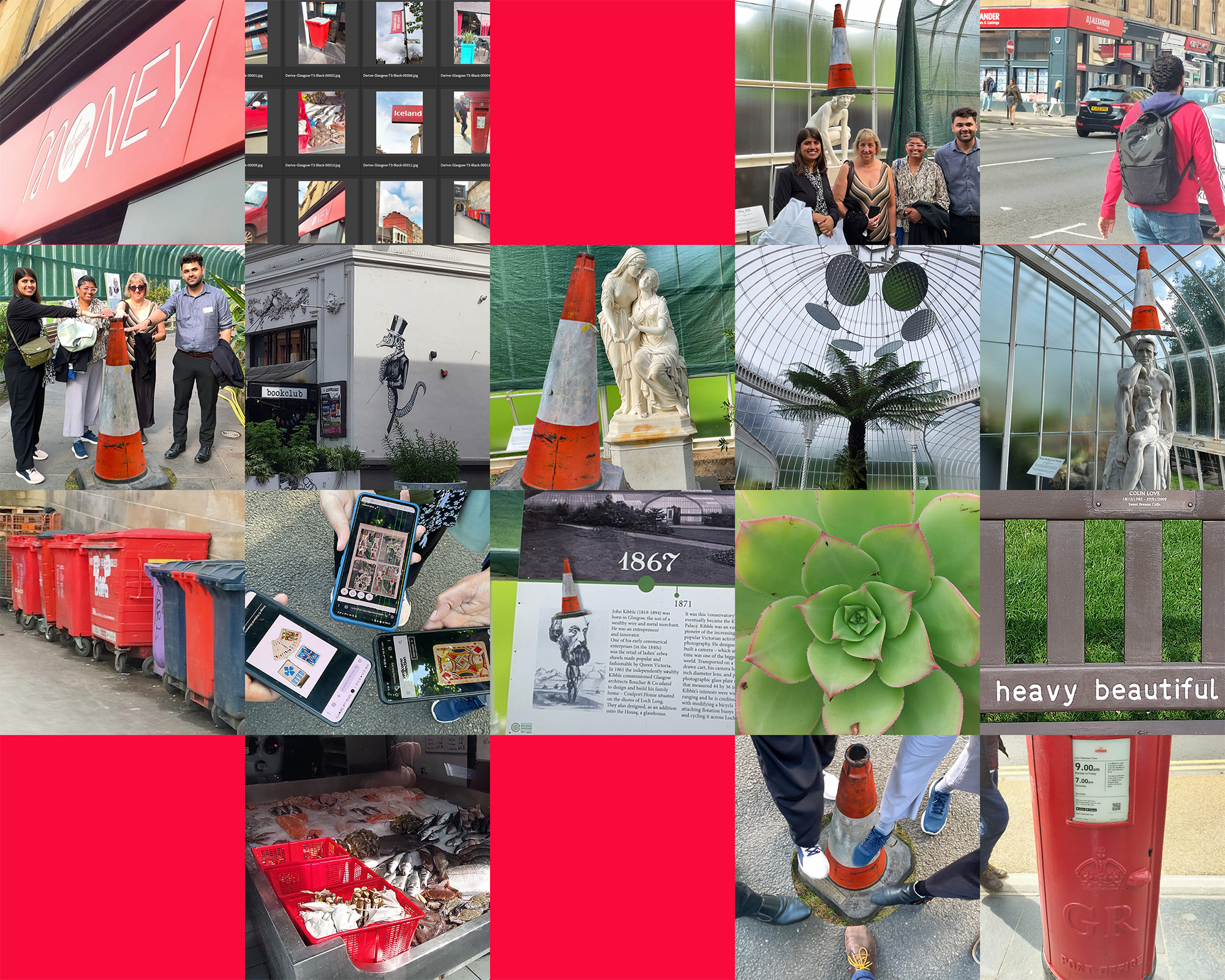20250617-UKIEDH-Glasgow
by Andy Corrigan
What Can Glasgow teach us?
A collaborative dérive for the hybrid age.
“The panorama-city is a “theoretical” (that is, visual) simulacrum, in short a picture, whose condition of possibility is an oblivion and a misunderstanding of practices.”
(de Certeau, 1984 , p. 93)1
Introduction
Language, walls and screens are boundaries, our experience of them is a way to cross their thresholds. This hybrid dérive, undertaken on 17/06/2025 as part of the UK-Ireland Digital Humanities Association’s 2025 Annual Event, was proposed as a way to question the theme of “Collaboration Beyond Boundaries”, seeking evidence of what we could learn or glean from the city of Glasgow. Its intention was to enable an embodied way to creatively explore, experience, discuss and answer this question, calling on participants to collaborate by applying their own skills, experience and background.
A dérive, defined by Guy Debord and the Situationist International in the 1950s, is a psychogeographical method of journeying through a landscape, and is characterised by transience, the varied ambience of the situation, and playfully constructive behaviour.2 Glasgow is no stranger to this concept – in the 1990s a group of artists and activists, the ‘Workshop for Non-Linear Architecture’, applied this theory as they undertook a ‘Psychogeographical Survey of Glasgow’.
The general dominance of images in contemporary culture, in particular through the digitisation of cultural artefacts, offers opportunities to re-contextualise and re-connect to physical reality, disrupt traditional concepts of space and time.3 Does this digital age create the conditions that afford a fresh perspective of the dérive? - The hybrid dérive!
After a brief introduction, participants were split into teams, each tasked with exploring a different location and gathering as much evidence of their experiences and findings as they can before returning to reconvene at the venue for the conference Plenary Session. Each team was assigned an iPad to use and a nearby area, provided with access to a pool of digital resources that relate to the city of Glasgow, as well as some suggested themes and challenges as prompts, and given access to a shared space to gather their evidence.
The rest was down to them!
I’d like to say a huge thank you to everyone that participated and assisted with delivering the event!
This activity was gratefully supported and funded by Cambridge Digital Humanities.
Locations
- Team 1 set out east to Kelvingrove Park
- Team 2 made their way south to Riverside and Govan Footbridge
- Team 3 went north to Kibble Palace in Glasgow Botanic Garden
- A fourth team was planned to explore the Glasgow Subway. [NB] This ended up impractical in the time available, but I have collected additional points of data and images from over the course of the conference which attest to this mode of transport that is so iconic to Glasgow.
Results
The dérive took place over 90 minutes. Each iPad used Strava to track the routes the teams took and record this as GPS data. These can be seen in the interactive map above. The digital resources, in a wide variety of different media and collections, and the evidence collected by the participants, which mostly consists of photographs and a couple of videos, are all mapped on, and can be explored using, the interactive map above (hosted at irisbox.github.io/UKIEDH-Derive), which uses the Peripleo tool. The photos are IIIF Level 0 compliant, hosted using the IIIF Workbench, and can also be browsed where they are hosted on GitHub at https://irisbox.github.io/Derive-Glasgow/.
Team 1: Kelvingrove Park Report

Team 4: Glasgow Subway Report

The Challenges
Each team was provided with a selection of pre-existing digital resources, as well as a variety of challenges as prompts. These challenges were conceived to encourage closer reading of their surroundings, as well as to encourage them to use and situate the digital resources as a method of augmenting that experience. The number of challenges far exceeds what could be feasible in a timeframe of 90 minutes to intentionally heighten the role of chance in which the teams were drawn to undertaking on their specific dérive. The challenges are all listed below to assist in interpreting the resulting evidence, but I also hope other’s might find inspiration and give them a go!
General (All Teams)
- Colours, Words & Palimpsests:
- At all times, keep your eyes peeled for things that the city is telling you which might answer our question? – remember to take photos!
- Which colours dominate your journey?
- Can you collect all the colours of the rainbow?
- What official or unofficial words and palimpsests (eg the ‘People Make Glasgow’ slogan or graffiti)
- Traffic Coning: The statue of Wellington riding his horse in the centre of Glasgow is world famous – it was once listed in Lonely Planet’s ‘Top 10 most bizarre monuments on Earth’! This is not due to Wellington’s fame, but for the Glaswegian expression of humour and spirit in placing a traffic cone on his head. Instructions:
- Each teams iPad has a 3D model of a traffic cone already in the Scaniverse App.
- Open the app and go to the “library” and select the traffic cone.
- Select “AR View” and you will be able to situate the model in augmented reality.
- You can adjust the size and position – use this feature to virtually place the cone on top of any statues you might encounter and remember to take a screenshot!
- The Joker: A game of incidental poker: In the 1990s a group of artists and activists, formed the ‘Workshop for Non-Linear Architecture’. They applied the theory of dérive as they undertook a ‘Psychogeographical Survey of Glasgow’. One of the few literary relics of this survey is a report in a 1997 volume, edited by artist Stewart Home, about ‘The Joker: A game of incidental poker’, an activity that centred on discarded playing cards that were found during their dérives.4 Instructions:
- When you come across an interesting location(s), use the list of QR Codes that lead to digitised playing cards: bit.ly/IncidentalPoker
- Anyone in the team who wants to, should select an example playing card and load its image on their mobile phone.
-
Situate the mobile phone(s) in the location in any way that you wish and then take photo(s) using the Team iPad.
- Contours, Currents & Vortexes: “Cities have psychogeographical contours, with constant currents, fixed points and vortexes”.5 This quote is from Guy Debord’s ‘Theory of the Dérive’. Instructions:
- Look at this photo of Jamaica Street Bridge in Glasgow, taken sometime between 1880 and 1920. At first the street seems fairly empty, but zoom in to the three boys near the centre foreground and you might notice that there are many ghostly figures moving around them.
- How is the city of Glasgow moving in the area that you are exploring? What kind of movement is there – people, cars, boats, planes, or what about wildlife or other nature?
-
Try and take photo’s that convey this somehow.
- 👁iSpy: Can you find…
- Any ways to re-situate some of your teams Digital Resources?
- Something old and new that echo each other juxtaposed?
- An example of nature and the built environment working together?
- Something old and new that echo each other juxtaposed?
- Any places or social acts unite us?
- An example of a collective endeavour?
- Anything that connects you to the city, or connects Glasgow to the place you live?
- Things that helped you find your way?
- Any sounds that might define the location?
-
Anything that keeps you safe?
Team 1 Specific
- There are quite a few statues in Kelvingrove Park – can you find and virtually “Traffic Cone” them all?
- Lord Roberts Monument
- Thomas Carlyle Statue
- Statue of Lord Kelvin
- Lord Lister Monument
- The Psalmist Sculpture
- The Tigress and Cubs
- Stewart Memorial Fountain
- How do the natural features of the river and park relate to the built environment?
- Can you find the Suffrage Oak?
- How is it doing after over 100 years?
- Can you record evidence of its current state?
- Can you re-unite it with any of the women who planted it?
Team 2 Specific
- Is the tide in or out? What indicators are there? What evidence is there of the impact of the tide?
- Can you find any evidence of how people crossed the river before the new bridge was built?
- Bridging the Clyde - a collective photo collage:
- Stand in a circle in the middle of the Govan Footbridge.
- Facing outwards away from each other, everyone take a photo and upload them to the evidence folder.
Team 3 Specific
- The Kibble Palace was originally converted from John Kibble’s own conservatory and moved here to house concerts and exhibitions.6 Can you “re-create” any music performances or displays of classical statues?
- One January morning in 1914, “militant” suffragettes tried to damage the Kibble Palace with a bomb. The police found a ladies silk scarf and the footprint of a high heel boot… can you re-create the “crime” scene?
- A Glass Ceiling - a collective photo collage: John Kibble once owned the world’s biggest camera (in 1858) how much of his “crystal palace” can you collectively capture at once?
- Stand in a circle near the middle of the Kibble Palace.
- Facing outwards away from each other, and a little up, everyone take a photo and upload them to the evidence folder.
Team 4 Specific
- Did you hear ‘The Underground Song’ in the digital resources? – Can you write a short verse or poem about your experience on the Glasgow Subway?
- The song ‘The Owl of Minerva’ by the Tenementals describes the city from a birds eye view – Can you think of ways to visualise the city from the perspective of a worm as you travel around underground?
- Do you prefer some stations to others? Explore ways to record your findings as evidence!
This activity was gratefully supported and funded by Cambridge Digital Humanities.
-
de Certeau, M. (1984), Walking in the City (S. F. Rendall, Trans.). California/London: University of California Press. (Original work published 1980). ↩
-
Knabb, K. (ed.). (1981) Situationist International Anthology. California: Bureau of Public Secrets. ↩
-
Andjelkovic, K. (2020), Architecture of Constructed Situation: Understanding the Perception of Urban Space through Media, in Akçay Kavakoğlu, A., Haciömeroğlu, T. N., & Landrum, L. (eds.), Narrating the city : mediated representations of architecture, urban forms and social life (pp. 96-111). Chicago/Bristol: Intellect Books. ↩
-
Workshop for a Non-Linear Architecture. (1997), The Joker: A Game of Incidental Poker, in Stewart Home (ed.), Mind Invaders (pp. 154-161). London: Serpent’s Tail. ↩
-
Debord, G. (1981), Theory of the Dérive. (K. Knabb, Trans.), in Ken Knabb (ed.), Situationist International Anthology (pp. 55-54). California: Bureau of Public Secrets. (Original work published 1958). ↩
-
Curtis, E. W. (1999), Kibble’s Palace. Scotland: Argyll Publishing. ↩


